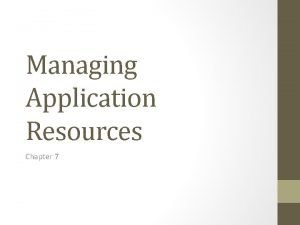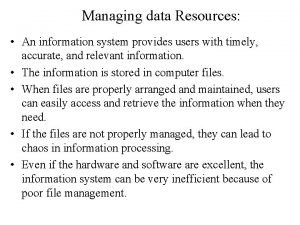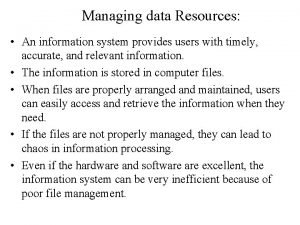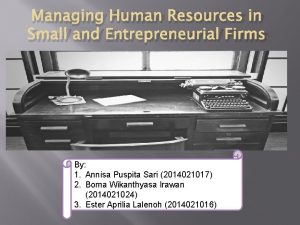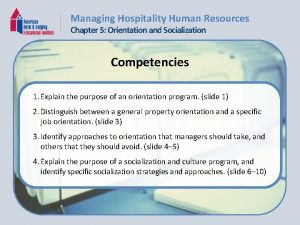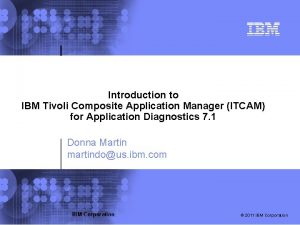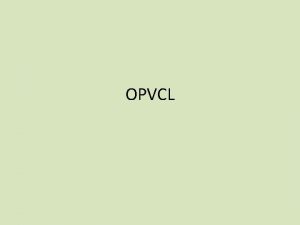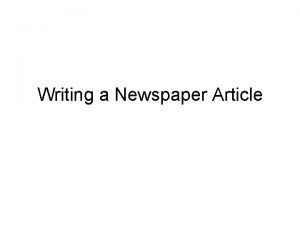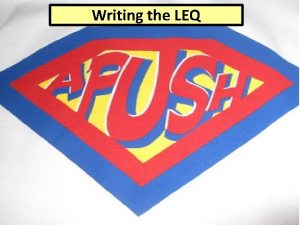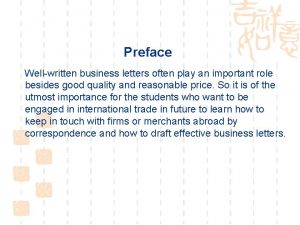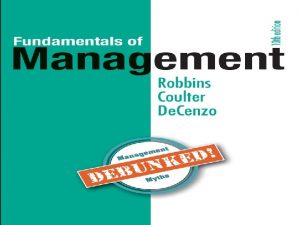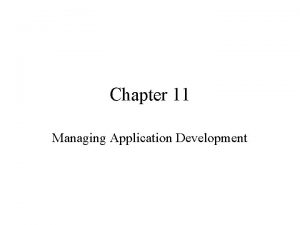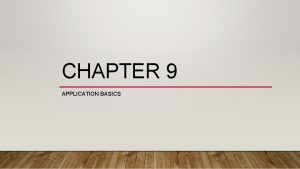Managing Application Resources Chapter 7 Resources Wellwritten applications














- Slides: 14

Managing Application Resources Chapter 7

Resources • Well-written applications access resources programmatically rather than hard-coding them in the source code • Android applications are composed of two things • Functionality – code instructions; determines how your application behaves • Data – resources; includes text strings, images, icons, audio files, videos, etc. • Android resource files are stored separately from the. java class files in a project • Common resources are stored in XML

Resources • Resources are organized in strict directory hierarchy • All resources are stored under the /res project directory in specially names subdirectories that must be lowercase • Different resources are stored in different folders • The resource subdirectories generated when you create an Android projects are shown below Resource Subdirecotry Purpose /res/drawable-*/ Graphics resources /res/layout/ User interface resources /res/values/ Simple data such as strings and color values

Resources • Resources can be organized in even more specially named directories • /res/drawable-hdpi • /res/drawable-lpdi • /res/drawable-mdpi • Eclipse with the Android Development Tools (ADT) makes adding resource simple • Resources are compiles, resulting in the generation of the R. java source file • Enables access to resources programmatically

Resources • All resource filenames must be lower-case and simple • Letters, numbers, and underscores only Resource Type Required Directory Suggested Filenames XML Tag Strings /res/values/ strings. xml <string> String Pluralization /res/values/ strings. xml <plurals>, <items> Arrays of Strings /res/values/ strings. xml or arrays. xml <string-array>, <item> Booleans /res/values/ bools. xml <bool> Colors /res/values/ colors. xml <color> Color State Lists /res/color/ buttonstates. xml, indicators. xml <selector>, <item>

Resources Resource Type Required Directory Suggested Filenames XML Tag Dimensions /res/values/ dimens. xml <dimen> Integers /res/values/ integers. xml <integer> Arrays of Integers /res/values/ integers. xml <integer-array> Mixed-Type Arrays /res/values/ arrays. xml <array>, <items> Simple Drawables (Paintable) /res/values/ drawables. xml <drawable> Graphics /res/drawable/ icon. png, logo. jpg Supported graphics files or drawable definition SML files Tweened Animations /res/anim/ fadesequence. xml, spensequence. xml <set>, <alpha>, <scale>, <translate>, <rotate>

Resources Resource Type Required Directory Suggested Filenames XML Tag Property Animations /res/animator/ mypropanims. xml <set>, <object. Animator>, < value. Animator> Frame-by-Frame Animations /res/drawable/ sequence 1. xml, sequence 2. xml <animation-list>, <item> Menus /res/menu/ mainmenu. xml, helpmenu. xml <menu> XML Files /res/xml/ data. xml, data 2. xml Defined by the developer

Resources Resource Type Required Directory Suggested Filenames XML Tag Raw Files /res/raw/ jingle. mp 3, somevideo. mp 4, helptext. txt Defined by the developer Layouts /res/layout/ main. xml, help. xml Varies. Must be a layout control styles. xml, themes. xml <style> Styles and Themes /res/values/ New resource types are added frequently to Android SDK.

Resources • Storing Primitive Resource Types • Simple resource types like strings, colors, and dimensions are stored under /res/values folder in XML files • Each resource file under /res/values folder should begin with following header: <? xml version=“ 1. 0” encoding=“utf-8”? > • Followed by root node <resources> • Followed by the specific resource element types like <string> or <color> • Each resource is defined using a different element name

Resources <? xml version=“ 1. 0” encoding=“utf-8”? > <resources> <string name=“app_name”>Use Some Resources</string> <string name=“hello”>Hello World, Use Some Resources</string> <color name=“pretty. Text. Color”>#ff 0000</color> <dimen name=“text. Point. Size”>14 pt</dimen> <drawable name=“red. Drawable”>#F 00</drawable> <string-array name=“flavors”> <item>Vanilla</item> <item>Chocolate</item> <item>Strawberry</item> </string-array> </resources>

Resources • Android platform has robust mechanism for loading appropriate resources at runtime • Useful to think of the resources stored at the directory hierarchy as the application’s default resources • Developer can supply special versions of resources to load instead of defaults under certain conditions • Specialized resources are called alternative resources • Common reasons to use alternative resources are: • Internationalization • Localization • Design application that runs smoothly on different device screens & orientations

Resources - Color • Android applications can store RGB color values • You can use the color values to set the color of text or backgrounds. • RGB color values always start with the hash symbol # • The alpha value can be given for transparency control • Following color formats are supported: • • #RGB – example is #F 00 for 12 -bit color red #ARGB – example is #8 F 00 for 12 -bit color read with alpha 50% #RRGGBB – example is #FF 00 FF 24 -bit color magenta #AARRGGBB – example is #80 FF 00 FF 24 -bit color magenta with alpha 50% • Color values are tagged with <color> tag in a name/value pair.

Resources - Dimensions • Many user interface layout controls like text controls and buttons are drawn to specific dimensions • Dimensions can be stored as resources Unit of Measurement Description Resource Tag Required Example Pixels Actual screen pixels px 20 px Inches Physical measurement in 5 in Millimeters Physical measurement mm 2 mm Points Common font measurement unit pt 14 pt Screen density – independent pixels Pixels relative to 160 dpi screen (preferable dimension for screen compatibility) dp 14 dp Scale-independent pixels Best for scalable font display sp 14 sp

 Managing application resources in a hierarchy
Managing application resources in a hierarchy Chapter 10 managing human resources
Chapter 10 managing human resources Managing human resources in small and entrepreneurial firms
Managing human resources in small and entrepreneurial firms Managing data resources
Managing data resources Managing human resources in small and entrepreneurial firms
Managing human resources in small and entrepreneurial firms Managing global human resources
Managing global human resources Need of hrm
Need of hrm Managing human resources snell
Managing human resources snell Managing data resources
Managing data resources Information technology resource management
Information technology resource management Managing human resources bohlander
Managing human resources bohlander Managing human resources in small and entrepreneurial firms
Managing human resources in small and entrepreneurial firms Managing hospitality human resources
Managing hospitality human resources Managing global human resources
Managing global human resources Ibm itcam
Ibm itcam
